Sudarsana Reddy Kadiri
Towards disentangling the contributions of articulation and acoustics in multimodal phoneme recognition
May 29, 2025Abstract:Although many previous studies have carried out multimodal learning with real-time MRI data that captures the audio-visual kinematics of the vocal tract during speech, these studies have been limited by their reliance on multi-speaker corpora. This prevents such models from learning a detailed relationship between acoustics and articulation due to considerable cross-speaker variability. In this study, we develop unimodal audio and video models as well as multimodal models for phoneme recognition using a long-form single-speaker MRI corpus, with the goal of disentangling and interpreting the contributions of each modality. Audio and multimodal models show similar performance on different phonetic manner classes but diverge on places of articulation. Interpretation of the models' latent space shows similar encoding of the phonetic space across audio and multimodal models, while the models' attention weights highlight differences in acoustic and articulatory timing for certain phonemes.
Enhancing Listened Speech Decoding from EEG via Parallel Phoneme Sequence Prediction
Jan 08, 2025



Abstract:Brain-computer interfaces (BCI) offer numerous human-centered application possibilities, particularly affecting people with neurological disorders. Text or speech decoding from brain activities is a relevant domain that could augment the quality of life for people with impaired speech perception. We propose a novel approach to enhance listened speech decoding from electroencephalography (EEG) signals by utilizing an auxiliary phoneme predictor that simultaneously decodes textual phoneme sequences. The proposed model architecture consists of three main parts: EEG module, speech module, and phoneme predictor. The EEG module learns to properly represent EEG signals into EEG embeddings. The speech module generates speech waveforms from the EEG embeddings. The phoneme predictor outputs the decoded phoneme sequences in text modality. Our proposed approach allows users to obtain decoded listened speech from EEG signals in both modalities (speech waveforms and textual phoneme sequences) simultaneously, eliminating the need for a concatenated sequential pipeline for each modality. The proposed approach also outperforms previous methods in both modalities. The source code and speech samples are publicly available.
Can a Machine Distinguish High and Low Amount of Social Creak in Speech?
Oct 22, 2024Abstract:Objectives: ncreased prevalence of social creak particularly among female speakers has been reported in several studies. The study of social creak has been previously conducted by combining perceptual evaluation of speech with conventional acoustical parameters such as the harmonic-to-noise ratio and cepstral peak prominence. In the current study, machine learning (ML) was used to automatically distinguish speech of low amount of social creak from speech of high amount of social creak. Methods: The amount of creak in continuous speech samples produced in Finnish by 90 female speakers was first perceptually assessed by two voice specialists. Based on their assessments, the speech samples were divided into two categories (low $vs$. high amount of creak). Using the speech signals and their creak labels, seven different ML models were trained. Three spectral representations were used as feature for each model. Results: The results show that the best performance (accuracy of 71.1\%) was obtained by the following two systems: an Adaboost classifier using the mel-spectrogram feature and a decision tree classifier using the mel-frequency cepstral coefficient feature. Conclusions: The study of social creak is becoming increasingly popular in sociolinguistic and vocological research. The conventional human perceptual assessment of the amount of creak is laborious and therefore ML technology could be used to assist researchers studying social creak. The classification systems reported in this study could be considered as baselines in future ML-based studies on social creak.
Evaluation of state-of-the-art ASR Models in Child-Adult Interactions
Sep 24, 2024



Abstract:The ability to reliably transcribe child-adult conversations in a clinical setting is valuable for diagnosis and understanding of numerous developmental disorders such as Autism Spectrum Disorder. Recent advances in deep learning architectures and availability of large scale transcribed data has led to development of speech foundation models that have shown dramatic improvements in ASR performance. However, the ability of these models to translate well to conversational child-adult interactions is under studied. In this work, we provide a comprehensive evaluation of ASR performance on a dataset containing child-adult interactions from autism diagnostic sessions, using Whisper, Wav2Vec2, HuBERT, and WavLM. We find that speech foundation models show a noticeable performance drop (15-20% absolute WER) for child speech compared to adult speech in the conversational setting. Then, we employ LoRA on the best performing zero shot model (whisper-large) to probe the effectiveness of fine-tuning in a low resource setting, resulting in ~8% absolute WER improvement for child speech and ~13% absolute WER improvement for adult speech.
MMSD-Net: Towards Multi-modal Stuttering Detection
Jul 16, 2024Abstract:Stuttering is a common speech impediment that is caused by irregular disruptions in speech production, affecting over 70 million people across the world. Standard automatic speech processing tools do not take speech ailments into account and are thereby not able to generate meaningful results when presented with stuttered speech as input. The automatic detection of stuttering is an integral step towards building efficient, context-aware speech processing systems. While previous approaches explore both statistical and neural approaches for stuttering detection, all of these methods are uni-modal in nature. This paper presents MMSD-Net, the first multi-modal neural framework for stuttering detection. Experiments and results demonstrate that incorporating the visual signal significantly aids stuttering detection, and our model yields an improvement of 2-17% in the F1-score over existing state-of-the-art uni-modal approaches.
Analysis and Detection of Pathological Voice using Glottal Source Features
Sep 25, 2023Abstract:Automatic detection of voice pathology enables objective assessment and earlier intervention for the diagnosis. This study provides a systematic analysis of glottal source features and investigates their effectiveness in voice pathology detection. Glottal source features are extracted using glottal flows estimated with the quasi-closed phase (QCP) glottal inverse filtering method, using approximate glottal source signals computed with the zero frequency filtering (ZFF) method, and using acoustic voice signals directly. In addition, we propose to derive mel-frequency cepstral coefficients (MFCCs) from the glottal source waveforms computed by QCP and ZFF to effectively capture the variations in glottal source spectra of pathological voice. Experiments were carried out using two databases, the Hospital Universitario Principe de Asturias (HUPA) database and the Saarbrucken Voice Disorders (SVD) database. Analysis of features revealed that the glottal source contains information that discriminates normal and pathological voice. Pathology detection experiments were carried out using support vector machine (SVM). From the detection experiments it was observed that the performance achieved with the studied glottal source features is comparable or better than that of conventional MFCCs and perceptual linear prediction (PLP) features. The best detection performance was achieved when the glottal source features were combined with the conventional MFCCs and PLP features, which indicates the complementary nature of the features.
Wav2vec-based Detection and Severity Level Classification of Dysarthria from Speech
Sep 25, 2023Abstract:Automatic detection and severity level classification of dysarthria directly from acoustic speech signals can be used as a tool in medical diagnosis. In this work, the pre-trained wav2vec 2.0 model is studied as a feature extractor to build detection and severity level classification systems for dysarthric speech. The experiments were carried out with the popularly used UA-speech database. In the detection experiments, the results revealed that the best performance was obtained using the embeddings from the first layer of the wav2vec model that yielded an absolute improvement of 1.23% in accuracy compared to the best performing baseline feature (spectrogram). In the studied severity level classification task, the results revealed that the embeddings from the final layer gave an absolute improvement of 10.62% in accuracy compared to the best baseline features (mel-frequency cepstral coefficients).
Time-Varying Quasi-Closed-Phase Analysis for Accurate Formant Tracking in Speech Signals
Aug 31, 2023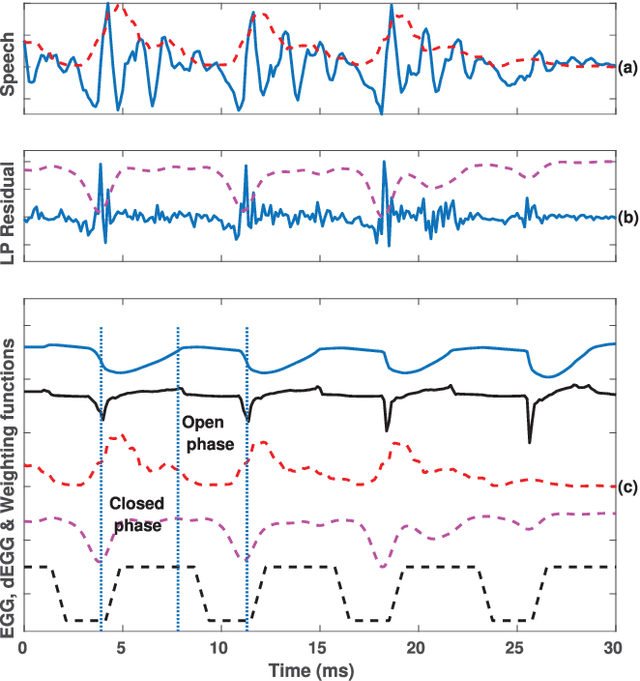
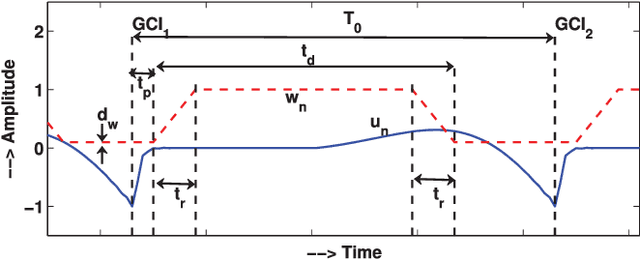

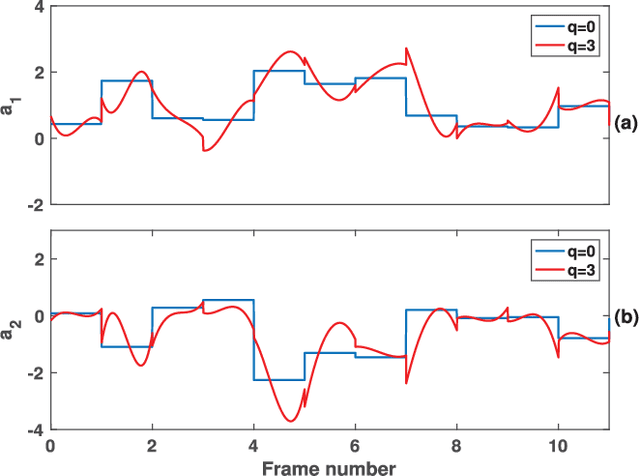
Abstract:In this paper, we propose a new method for the accurate estimation and tracking of formants in speech signals using time-varying quasi-closed-phase (TVQCP) analysis. Conventional formant tracking methods typically adopt a two-stage estimate-and-track strategy wherein an initial set of formant candidates are estimated using short-time analysis (e.g., 10--50 ms), followed by a tracking stage based on dynamic programming or a linear state-space model. One of the main disadvantages of these approaches is that the tracking stage, however good it may be, cannot improve upon the formant estimation accuracy of the first stage. The proposed TVQCP method provides a single-stage formant tracking that combines the estimation and tracking stages into one. TVQCP analysis combines three approaches to improve formant estimation and tracking: (1) it uses temporally weighted quasi-closed-phase analysis to derive closed-phase estimates of the vocal tract with reduced interference from the excitation source, (2) it increases the residual sparsity by using the $L_1$ optimization and (3) it uses time-varying linear prediction analysis over long time windows (e.g., 100--200 ms) to impose a continuity constraint on the vocal tract model and hence on the formant trajectories. Formant tracking experiments with a wide variety of synthetic and natural speech signals show that the proposed TVQCP method performs better than conventional and popular formant tracking tools, such as Wavesurfer and Praat (based on dynamic programming), the KARMA algorithm (based on Kalman filtering), and DeepFormants (based on deep neural networks trained in a supervised manner). Matlab scripts for the proposed method can be found at: https://github.com/njaygowda/ftrack
Severity Classification of Parkinson's Disease from Speech using Single Frequency Filtering-based Features
Aug 17, 2023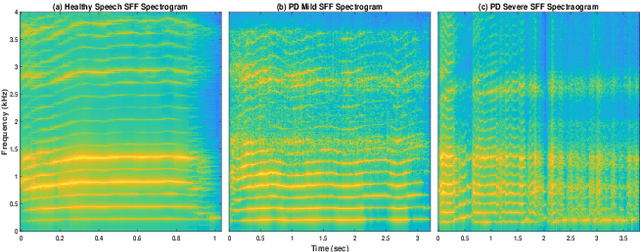
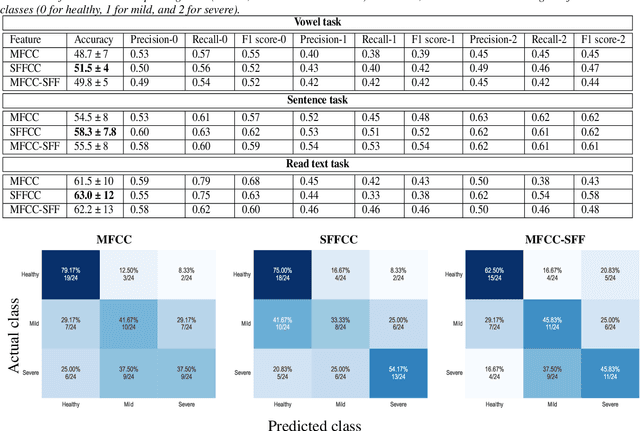
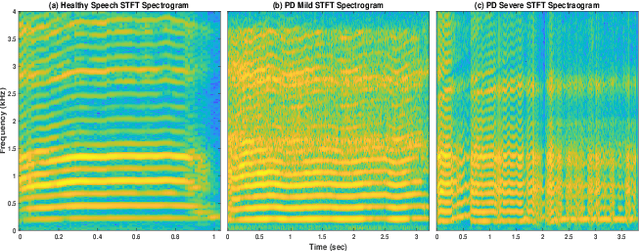
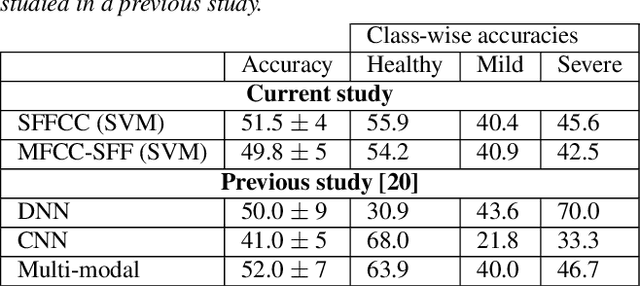
Abstract:Developing objective methods for assessing the severity of Parkinson's disease (PD) is crucial for improving the diagnosis and treatment. This study proposes two sets of novel features derived from the single frequency filtering (SFF) method: (1) SFF cepstral coefficients (SFFCC) and (2) MFCCs from the SFF (MFCC-SFF) for the severity classification of PD. Prior studies have demonstrated that SFF offers greater spectro-temporal resolution compared to the short-time Fourier transform. The study uses the PC-GITA database, which includes speech of PD patients and healthy controls produced in three speaking tasks (vowels, sentences, text reading). Experiments using the SVM classifier revealed that the proposed features outperformed the conventional MFCCs in all three speaking tasks. The proposed SFFCC and MFCC-SFF features gave a relative improvement of 5.8% and 2.3% for the vowel task, 7.0% & 1.8% for the sentence task, and 2.4% and 1.1% for the read text task, in comparison to MFCC features.
Refining a Deep Learning-based Formant Tracker using Linear Prediction Methods
Aug 17, 2023Abstract:In this study, formant tracking is investigated by refining the formants tracked by an existing data-driven tracker, DeepFormants, using the formants estimated in a model-driven manner by linear prediction (LP)-based methods. As LP-based formant estimation methods, conventional covariance analysis (LP-COV) and the recently proposed quasi-closed phase forward-backward (QCP-FB) analysis are used. In the proposed refinement approach, the contours of the three lowest formants are first predicted by the data-driven DeepFormants tracker, and the predicted formants are replaced frame-wise with local spectral peaks shown by the model-driven LP-based methods. The refinement procedure can be plugged into the DeepFormants tracker with no need for any new data learning. Two refined DeepFormants trackers were compared with the original DeepFormants and with five known traditional trackers using the popular vocal tract resonance (VTR) corpus. The results indicated that the data-driven DeepFormants trackers outperformed the conventional trackers and that the best performance was obtained by refining the formants predicted by DeepFormants using QCP-FB analysis. In addition, by tracking formants using VTR speech that was corrupted by additive noise, the study showed that the refined DeepFormants trackers were more resilient to noise than the reference trackers. In general, these results suggest that LP-based model-driven approaches, which have traditionally been used in formant estimation, can be combined with a modern data-driven tracker easily with no further training to improve the tracker's performance.
 Add to Chrome
Add to Chrome Add to Firefox
Add to Firefox Add to Edge
Add to Edge